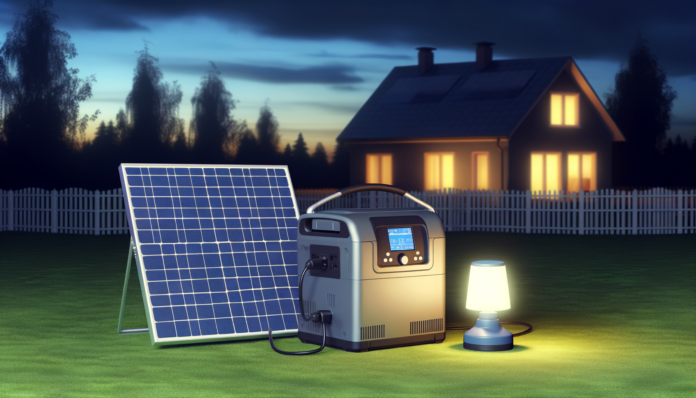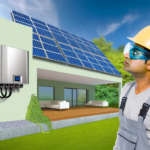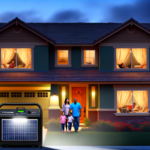Introduction to Solar Generators
What is a Solar Generator?
A solar generator is a device that converts sunlight into electrical energy, which can then be used to power various appliances and devices. Unlike traditional generators that rely on fossil fuels, solar generators harness the sun’s energy through solar panels. These panels capture sunlight and convert it into direct current (DC) electricity, which is then stored in a battery. An inverter converts the stored DC electricity into alternating current (AC), making it usable for household appliances and other electronic devices. Solar generators are typically portable, making them ideal for use in a variety of settings, including homes, RVs, and outdoor activities.
Why Consider a Solar Generator for Power Outages?
Power outages can be disruptive and inconvenient, especially when they last for extended periods. Solar generators offer a reliable and sustainable solution for such situations. Here are some reasons to consider a solar generator for power outages:
- Reliability: Solar generators provide a dependable source of power during outages, ensuring that essential appliances and devices remain operational.
- Portability: Many solar generators are designed to be portable, making them easy to transport and set up wherever needed.
- Ease of Use: Solar generators are generally user-friendly, requiring minimal setup and maintenance compared to traditional generators.
- Quiet Operation: Unlike gas-powered generators, solar generators operate quietly, making them suitable for use in residential areas without causing noise pollution.
Environmental and Economic Benefits
Solar generators offer several environmental and economic advantages over traditional fossil fuel-powered generators:
- Free Energy from the Sun: Once the initial investment in solar panels and the generator is made, the energy harnessed from the sun is free. This can lead to significant savings on fuel costs over time.
- Low Maintenance Costs: Solar generators have no moving parts and do not require liquid fuel, reducing the likelihood of mechanical issues and the need for repairs. This translates to lower maintenance costs.
- Clean and Quiet Operation: Solar generators produce no emissions, making them an environmentally friendly option. They also operate quietly, which is a significant advantage over noisy gas generators.
- Reduced Carbon Footprint: By using solar energy, you reduce your reliance on fossil fuels, thereby decreasing your carbon footprint and contributing to a cleaner environment.
In summary, solar generators are an excellent choice for those looking to ensure a reliable power supply during outages while also benefiting from the environmental and economic advantages of renewable energy. Whether for emergency preparedness, outdoor activities, or reducing your carbon footprint, solar generators offer a versatile and sustainable solution.
How Solar Generators Work
Basic Components
Solar generators are composed of several key components that work together to capture, convert, store, and distribute solar energy. These components include:
- Solar Panels: These are the primary devices that capture sunlight and convert it into direct current (DC) electricity. Solar panels are typically made up of photovoltaic (PV) cells that harness the sun’s energy.
- Charge Controller: This component regulates the voltage and current coming from the solar panels to the battery. It ensures that the battery is charged efficiently and prevents overcharging, which can damage the battery.
- Battery: The battery stores the electricity generated by the solar panels for later use. This stored energy can be used when sunlight is not available, such as during the night or on cloudy days.
- Inverter: The inverter converts the stored DC electricity in the battery into alternating current (AC) electricity, which is the standard form of electricity used by most household appliances and devices.
Energy Conversion Process
The process of converting solar energy into usable electrical power involves several steps:
- Solar Energy Capture: Solar panels capture sunlight and convert it into DC electricity through the photovoltaic effect. This effect occurs when sunlight excites electrons in the PV cells, creating an electric current.
- Regulation by Charge Controller: The DC electricity generated by the solar panels is then sent to the charge controller. The charge controller ensures that the electricity is delivered to the battery at the correct voltage and current, preventing overcharging and optimizing the charging process.
- Energy Storage: The regulated DC electricity is stored in the battery. The capacity of the battery determines how much energy can be stored and used later.
- Conversion to AC Power: When electricity is needed, the stored DC power in the battery is sent to the inverter. The inverter converts the DC electricity into AC electricity, making it compatible with household appliances and devices.
- Power Distribution: The AC electricity is then distributed to power various devices and appliances as needed. This process ensures a steady and reliable supply of electricity, even when the sun is not shining.
Battery Storage and Capacity
The battery is a crucial component of a solar generator, as it stores the energy generated by the solar panels for later use. The capacity and type of battery used can significantly impact the performance and efficiency of the solar generator.
- Battery Capacity: Battery capacity is measured in watt-hours (Wh) or kilowatt-hours (kWh) and indicates the total amount of energy the battery can store. A higher capacity battery can store more energy, allowing for longer usage periods without recharging. For example, a 1000Wh battery can power a 100-watt device for 10 hours.
- Battery Types: The most common types of batteries used in solar generators are lithium-ion and lead-acid batteries. Lithium-ion batteries are preferred for their higher energy density, longer lifespan, and lighter weight. Lead-acid batteries are more affordable but are heavier and have a shorter lifespan.
- Efficiency and Lifespan: The efficiency of a battery refers to how well it can store and release energy. Lithium-ion batteries typically have higher efficiency rates compared to lead-acid batteries. The lifespan of a battery is influenced by factors such as the number of charge cycles it can undergo and how well it is maintained.
In summary, understanding how solar generators work involves recognizing the roles of their basic components, the energy conversion process, and the importance of battery storage and capacity. These elements work together to provide a reliable and sustainable source of electricity, making solar generators an excellent choice for backup power during outages and for off-grid living.
Types of Solar Generators
Portable Solar Generators
Portable solar generators are compact, lightweight, and designed for mobility. They are ideal for outdoor activities such as camping, road trips, and emergency situations. These generators typically come with built-in batteries, inverters, and multiple outlets, including USB ports, AC outlets, and sometimes even wireless charging pads.
**Key Features:**
– **Portability:** Easy to carry and transport.
– **Versatility:** Can power small devices like smartphones, laptops, and small appliances.
– **Ease of Use:** Simple setup and operation, often with plug-and-play functionality.
– **Eco-Friendly:** No emissions and quiet operation.
**Use Cases:**
– **Camping and Outdoor Activities:** Provides power for lights, cooking equipment, and electronic devices.
– **Emergency Preparedness:** Acts as a reliable backup during power outages.
– **Remote Work:** Ideal for digital nomads who need to power laptops and other devices on the go.
Home Backup Solar Generators
Home backup solar generators are designed to provide a reliable power source for households during power outages. These systems are larger and more powerful than portable generators, capable of running essential home appliances like refrigerators, lights, and medical equipment.
**Key Features:**
– **High Capacity:** Larger battery storage and higher power output.
– **Scalability:** Can be expanded with additional solar panels and batteries.
– **Integration:** Often integrated with home electrical systems for seamless operation.
– **Durability:** Built to withstand long-term use and harsh weather conditions.
**Use Cases:**
– **Power Outages:** Keeps essential appliances running during blackouts.
– **Sustainable Living:** Reduces reliance on the grid and lowers electricity bills.
– **Critical Applications:** Ensures continuous power for medical devices and home security systems.
Hybrid Solar Generators
Hybrid solar generators combine solar power with other energy sources, such as wind or traditional fuel generators. This hybrid approach ensures a more reliable and consistent power supply, especially in areas with variable weather conditions.
**Key Features:**
– **Multiple Power Sources:** Utilizes solar, wind, and fuel to generate electricity.
– **Reliability:** Provides continuous power even when solar energy is insufficient.
– **Efficiency:** Optimizes energy use by switching between different power sources.
– **Flexibility:** Suitable for both residential and commercial applications.
**Use Cases:**
– **Off-Grid Living:** Ideal for remote locations where grid power is unavailable.
– **Commercial Use:** Powers businesses and industrial equipment with a reliable energy mix.
– **Disaster Preparedness:** Ensures a steady power supply during natural disasters and emergencies.
In summary, the type of solar generator you choose depends on your specific needs and circumstances. Portable solar generators are perfect for mobility and small-scale use, home backup generators provide robust power for household needs, and hybrid generators offer the most reliable and versatile solution by combining multiple energy sources. Each type has its unique advantages, making solar generators a versatile and eco-friendly option for various applications.
Choosing the Right Solar Generator
Assessing Your Power Needs
Before diving into the world of solar generators, it’s crucial to understand your power requirements. Start by listing all the devices and appliances you plan to power during an outage. This list might include essentials like lights, refrigerators, medical equipment, and communication devices. Each device has a specific wattage requirement, which you can usually find on a label or in the user manual.
To calculate your total power needs, add up the wattage of all the devices you plan to run simultaneously. For instance, if you need to power a refrigerator (800 watts), a few lights (100 watts), and a laptop (50 watts), your total power requirement would be 950 watts. It’s wise to add a buffer of about 20% to account for any unexpected power surges or additional devices, bringing your total to approximately 1140 watts.
Key Features to Look For
When choosing a solar generator, several key features can significantly impact its performance and suitability for your needs:
- Battery Capacity: Measured in watt-hours (Wh), this indicates how much energy the generator can store. A higher capacity means longer run times for your devices.
- Power Output: This is the maximum wattage the generator can provide at any given time. Ensure the generator’s output exceeds your total power needs.
- Portability: Consider the weight and size of the generator, especially if you plan to use it for outdoor activities or need to move it frequently.
- Charging Speed: Look for generators with fast charging capabilities, both from solar panels and other sources like wall outlets or car chargers.
- Number and Types of Outlets: Ensure the generator has enough outlets to accommodate all your devices, including USB ports, AC outlets, and DC car ports.
- Battery Type: Lithium-ion batteries are common due to their efficiency and longevity, but lithium iron phosphate (LiFePO4) batteries offer even greater safety and longer life cycles.
- Expandability: Some models allow you to add extra battery packs or solar panels to increase capacity and charging speed.
Comparing Different Models
With numerous models on the market, comparing them can be daunting. Here are some popular models and their specifications to help you make an informed decision:
| Model | Battery Capacity (Wh) | Power Output (W) | Weight (lbs) | Price (INR approx.) |
|---|---|---|---|---|
| EcoFlow RIVER 2 Pro | 768 | 800 | 17.8 | 38,990 |
| Anker SOLIX F2000 (PowerHouse 767) | 2,000+ | 2,000 | 67.5 | Not Available |
| OUPES 1200 | 1,200 | 1,200 | 24.3 | 40,999 |
| EcoFlow DELTA 2 Max | 2,000+ | 2,400 | 52.2 | 1,54,999 |
| Bluetti AC300 + B300 combo | 3,072 | 3,000 | 132 | 1,92,999 |
When comparing models, consider not only the specifications but also user reviews and brand reputation. Reliable brands often offer better customer support and warranties, ensuring peace of mind with your investment.
In conclusion, choosing the right solar generator involves understanding your power needs, identifying key features, and comparing different models. By carefully considering these factors, you can select a solar generator that provides reliable, eco-friendly power during outages and beyond.
Setting Up and Using Your Solar Generator
Installation Guide
Setting up a solar generator involves several key steps to ensure optimal performance and safety. Here’s a step-by-step guide to help you get started:
1. **Choose the Right Location**:
– **Solar Panels**: Place your solar panels in an area that receives maximum sunlight throughout the day. Rooftops, open fields, or any unshaded area are ideal.
– **Generator Placement**: Position the generator in a dry, cool, and well-ventilated area. Avoid placing it in direct sunlight to prevent overheating.
2. **Connect the Components**:
– **Solar Panels to Charge Controller**: Connect the solar panels to the charge controller using the appropriate cables. This controller regulates the voltage and current coming from the panels to prevent overcharging.
– **Charge Controller to Battery**: Attach the charge controller to the battery. This connection allows the battery to store the energy captured by the solar panels.
– **Battery to Inverter**: Connect the battery to the inverter. The inverter converts the stored DC power into AC power, which is usable by most household appliances.
3. **Test the System**:
– Ensure all connections are secure and test the system by powering a small device. Check the charge controller and inverter displays to confirm that the system is functioning correctly.
Safety Precautions
Using a solar generator safely is crucial to prevent accidents and ensure longevity. Here are some essential safety tips:
1. **Avoid Overloading**:
– Do not connect devices that exceed the generator’s power capacity. Overloading can damage the generator and connected devices.
2. **Proper Ventilation**:
– Ensure the generator is placed in a well-ventilated area to prevent overheating. Avoid enclosing the generator in tight spaces.
3. **Regular Inspections**:
– Periodically check all connections and components for signs of wear or damage. Replace any faulty parts immediately.
4. **Battery Handling**:
– Handle batteries with care. Avoid short-circuiting the terminals and follow the manufacturer’s guidelines for charging and discharging.
5. **Emergency Shutdown**:
– Familiarize yourself with the emergency shutdown procedure. In case of any malfunction, disconnect the solar panels first, followed by the battery and inverter.
Maintenance Tips
Regular maintenance ensures that your solar generator operates efficiently and has a long lifespan. Here are some maintenance tips:
1. **Clean the Solar Panels**:
– Dust and debris can reduce the efficiency of solar panels. Clean them regularly with a soft cloth and mild detergent. Avoid using abrasive materials that can scratch the surface.
2. **Check Battery Health**:
– Monitor the battery’s charge and discharge cycles. Ensure it is not overcharged or deeply discharged frequently, as this can reduce its lifespan. Use a battery monitor to keep track of its health.
3. **Inspect Connections**:
– Regularly inspect all electrical connections for corrosion or loose fittings. Tighten any loose connections and clean any corroded terminals.
4. **Firmware Updates**:
– If your solar generator has a digital interface, check for firmware updates from the manufacturer. These updates can improve performance and add new features.
5. **Store Properly**:
– If you need to store the generator for an extended period, ensure the battery is charged to about 50% and store it in a cool, dry place. Avoid storing it in extreme temperatures.
By following these guidelines, you can ensure that your solar generator is set up correctly, used safely, and maintained properly, providing you with reliable and sustainable power during outages and other situations.
Real-World Applications
Emergency Preparedness
In times of crisis, having a reliable power source can be a lifesaver. **Solar generators** are an excellent choice for emergency preparedness due to their ability to provide power without relying on fossil fuels. Unlike traditional gas-powered generators, solar generators are quiet, produce no emissions, and can be used indoors. They can keep essential devices like medical equipment, communication devices, and refrigerators running during power outages. For instance, the **Jackery Solar Generator 2000 Pro** can power a refrigerator for several hours, ensuring that food and medicine remain safe. Additionally, solar generators can be recharged using solar panels, making them a sustainable option during prolonged outages.
Outdoor Activities
For outdoor enthusiasts, solar generators offer a convenient and eco-friendly way to power devices while enjoying nature. Whether you’re camping, hiking, or on a road trip, a portable solar generator can keep your gadgets charged and your campsite illuminated. Models like the **EcoFlow Delta Mini** are compact and lightweight, making them easy to transport. They can power a range of devices, from smartphones and laptops to portable fridges and lights. The ability to recharge using solar panels means you can stay off-grid longer without worrying about running out of power. This makes solar generators an ideal companion for those who love to explore the great outdoors.
Living Off-Grid
For those who choose to live off-grid, solar generators provide a sustainable and reliable power solution. They can be used to power homes, cabins, or RVs, reducing dependence on traditional power sources. **Home backup solar generators** like the **Bluetti AC200P** offer high capacity and multiple output options, making them suitable for powering household appliances and electronics. These generators can be paired with solar panels to create a complete off-grid power system. Innovations in battery technology and energy storage capacity mean that modern solar generators can store enough power to meet daily energy needs, even in remote locations. This makes them a viable option for those seeking a self-sufficient lifestyle.
In conclusion, solar generators are versatile tools that can be used in various real-world applications. Whether you’re preparing for emergencies, enjoying outdoor activities, or living off-grid, a solar generator can provide a reliable and eco-friendly power source.
Future Trends in Solar Generator Technology
Advancements in Solar Panels
The efficiency of solar panels has seen remarkable improvements over the past decade, and this trend is set to continue. Modern photovoltaic cells are now capable of converting a higher percentage of sunlight into electricity, thanks to innovations in materials and manufacturing processes. **Perovskite solar cells**, for instance, are emerging as a promising technology due to their high efficiency and lower production costs compared to traditional silicon-based cells. Additionally, **bifacial solar panels**, which can capture sunlight from both sides, are becoming more prevalent, further enhancing energy capture and overall efficiency.
Innovations in Battery Technology
Battery technology is another critical area experiencing rapid advancements. The development of **solid-state batteries** promises to revolutionize the solar generator market. These batteries offer higher energy densities, longer lifespans, and improved safety compared to conventional lithium-ion batteries. Moreover, **lithium iron phosphate (LiFePO4) batteries** are gaining popularity due to their stability, longer cycle life, and environmental benefits. These innovations are making solar generators more reliable and capable of storing larger amounts of energy, which is crucial for extended power outages and off-grid applications.
Integration with Smart Home Systems
As smart home technology becomes more widespread, solar generators are increasingly being designed to integrate seamlessly with these systems. This integration allows for **remote monitoring and control** of the generator via smartphones or other smart devices. Homeowners can track energy production, storage levels, and consumption in real-time, optimizing their energy usage for maximum efficiency. Additionally, smart home integration enables **automated energy management**, where the system can prioritize the use of solar power over grid electricity, reducing energy costs and enhancing sustainability.
In conclusion, the future of solar generators is bright, with significant advancements in solar panel efficiency, battery technology, and smart home integration. These innovations are making solar generators more efficient, reliable, and user-friendly, ensuring they play a crucial role in the transition to sustainable energy solutions.






